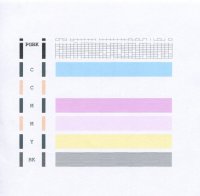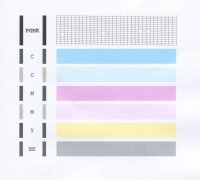FTD
Printing Apprentice
- Joined
- Jan 18, 2015
- Messages
- 2
- Reaction score
- 0
- Points
- 12
- Printer Model
- ip4300
I have a IP4300 that is several years old, and has been sitting unused for about six months. Foolishly, I let it sit rather than printing an occasional page or two. I left the cartridges in the head thinking it would be best to keep ink from drying on the screens, but drying of the ink in the heads caused some blockage as seen in the pattern on the first test page I posted. To try and open up the heads I soaked the head in warm water for a few hours with little success. I then tried resting the print head on a Windex soaked paper towel, and adding drops directly to the screens repeatedly as it flowed through. After about two hours I rinsed the head with water and tried printing again. The pattern improved greatly, but there still are a few lines missing on the grid pattern. I repeated the Windex soaked paper towel twice, first for two and then about four hours... no improvement. What I am wondering is what the pattern shows? No matter how many test pages I print, or ink cleanings I run, the pattern is always the same. So does this mean a single specific jet is blocked, or since there are four lines missing that four jets are blocked, or does it mean something completely different? In general if I print a text test page it looks O.K., but there is occasionally a dark line in the other colors (for example if I print the Google home page there will be a thin dark line running through "Google"). In addition, now after each print I hear what sounds like the cartridges purging. I don't remember that happening so frequently before.





